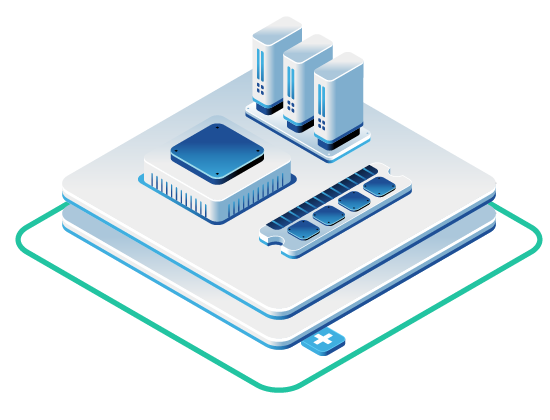
Runway Intelligence is OpenMetal’s executive insight series for late-stage startups and their investors, exploring how cloud economics, infrastructure design, and operational strategy shape valuation, margins, and time to exit.
Key Takeaways
- Broadcom’s VMware transformation has triggered price increases ranging from 150% to 1,200% for many customers through mandatory subscription bundles and per-core licensing
- Hyperscaler costs remain unpredictable, with 42% of businesses unable to predict monthly cloud bills and 28% reporting unexpectedly large charges
- Cloud spending now consumes 6-11% or more of revenue for most SaaS companies, directly eroding margins that determine valuation multiples
- Open-source platforms like OpenStack and Ceph provide workload portability, transparent pricing, and control without vendor lock-in
- Infrastructure strategy should be modeled as a margin optimization exercise, not just a technical migration project
You’re not choosing between clouds. You’re choosing between margins.
That’s the reality facing CTOs and CFOs at late-stage startups in 2025. Broadcom’s acquisition of VMware eliminated the comfortable middle ground where many companies built their infrastructure. Subscription-only licensing, forced bundling, and per-core pricing have pushed renewal costs up by 150% to over 1,200% for customers who once relied on predictable perpetual licenses. Meanwhile, hyperscalers promise scale and speed but deliver billing opacity and cost volatility that make financial planning nearly impossible.
The question isn’t whether to migrate. The question is where to land without sacrificing either control or cash flow.
The Broadcom Shock: When Comfort Becomes Unaffordable
Broadcom’s $69 billion acquisition of VMware in November 2023 marked the end of an era for enterprise virtualization. The company moved quickly to transform VMware from a product portfolio into a subscription-only platform, eliminating perpetual licenses and consolidating approximately 168 products into just four primary offerings: VMware Cloud Foundation and VMware vSphere Foundation, plus targeted editions for smaller deployments.
The financial impact hit immediately. Customers report price increases ranging from 150% to well over 1,000% at renewal. AT&T publicly claimed a proposed 1,050% increase. A British university faced projections jumping from £40,000 to £500,000 annually. European cloud providers documented cost surges of 800% to 1,500%, prompting formal competition complaints to the European Commission.
Three structural changes drove the cost explosion. First, Broadcom eliminated perpetual licensing entirely, forcing all customers onto recurring subscriptions regardless of their preference for upfront capital expenditure. Second, the company shifted from per-CPU to per-core licensing while raising minimum core requirements from 16 to 72 cores per subscription starting April 2025. For organizations running smaller deployments or edge locations, this means paying for capacity they’ll never use. Third, product bundling forces customers to purchase features they don’t need — buying VMware Cloud Foundation when they only require vSphere, paying for NSX and vSAN whether or not those capabilities matter to their architecture.
The contractual flexibility that made VMware palatable disappeared. Organizations that built multi-year infrastructure plans around predictable renewal costs now face forced reclassification as “strategic customers” with entirely different pricing structures. For late-stage startups operating under board scrutiny and preparing for profitability milestones, these surprise increases directly threaten financial projections and valuation multiples.
The Hyperscaler Illusion: Scale Without Predictability
Public cloud promised to solve the cost problem with consumption-based pricing and infinite scale. But the reality for late-stage startups tells a different story.
Hyperscaler costs continue rising despite competitive pressure. Research from 2024 and 2025 shows that 42% of businesses using AWS, Azure, or Google Cloud cannot easily predict their monthly bill. More than one in four organizations report receiving unexpectedly large invoices. Cloud cost inflation may have slowed recently, but consumption continues driving spending upward, with global cloud spending reaching $330 billion in 2024 — a $60 billion year-over-year increase.
The pricing structure creates the problem. Hyperscalers offer hundreds of service tiers, each with its own billing model, hidden egress fees, API request charges, and inter-region transfer costs. What appears transparent becomes opaque at scale. Storage classes multiply. Compute options proliferate. Add AI workloads — which require 100 times more computing resources than previous-generation models — and costs spiral beyond financial planning horizons.
For SaaS companies, the impact shows directly in margins. Cloud spending now represents one of the top three expense categories, with 73% of companies reporting that cloud costs consume at least 6% of revenue. For 31% of organizations, cloud costs eat up 11% or more of revenue. When SaaS gross margin benchmarks range from 70% to 85%, that 6-11% cloud cost becomes the difference between a company valued at 8x revenue versus 4x revenue.
Vendor lock-in amplifies the risk. Migrating data out of hyperscaler platforms triggers high egress fees that make switching cost-prohibitive. Proprietary services create technical dependencies that compound over time. Organizations find themselves trapped in consumption-based pricing models where temporary resource scaling decisions become permanent cost commitments. Gartner estimates that more than 60% of organizations exceed their cloud budgets due to poor visibility and optimization processes.
Late-stage startups face particular pressure. Unlike enterprises with massive scale or early-stage companies burning investor capital, late-stage organizations must balance growth velocity with margin discipline. CFOs need to model one-year total cost before board meetings. VCs managing portfolio companies post-correction need predictable OPEX that supports valuation assumptions rather than destroying them.
The False Binary: Legacy Stagnation Versus Cloud Volatility
The infrastructure market presents itself as a binary choice. Stay on VMware and accept declining flexibility with rising costs, or move to hyperscale cloud and trade control for unpredictable bills. Both options lead to the same outcome: margin compression that directly impacts business valuation.
VMware offers familiarity but represents stagnation. Organizations built years of operational knowledge around vSphere, vCenter, and vSAN. Teams understand the tooling. Workloads run predictably. But Broadcom’s transformation removed the affordability that justified that familiarity. Subscription bundling forces purchase of capabilities that provide zero incremental value. Per-core minimums create waste. Contractual inflexibility eliminates negotiating leverage. The result is infrastructure that costs more while delivering less strategic value.
Hyperscalers provide innovation velocity but sacrifice financial predictability. AWS, Azure, and Google Cloud enable rapid deployment, global scale, and access to emerging technologies. But that speed comes with billing complexity that makes budgeting nearly impossible. Development teams spin up resources without cost visibility. AI features carry premium pricing without clear ROI tracking. Monthly invoices arrive with line items that require forensic analysis to understand. For organizations approaching profitability milestones or preparing for funding rounds, this opacity creates material risk.
A third option exists: open infrastructure platforms built on technologies like OpenStack and Ceph that provide the control of private cloud with the operational simplicity of managed services. This approach restores ownership of cost behavior, eliminates vendor lock-in, and enables workload portability without sacrificing innovation velocity.
Framework for Replatforming Decisions
Infrastructure strategy decisions should follow a framework that balances technical requirements with financial impact. Three pillars define the evaluation:
Workload portability and compatibility determine how easily applications move between environments. Proprietary hyperscaler services create dependencies that increase switching costs over time. Open standards enable portability. Containers and Kubernetes provide abstraction. Organizations should assess which workloads require hyperscaler-specific features versus which can run on standard compute, storage, and networking. Development and test environments, stateful applications, and workloads with predictable resource requirements often perform identically on open infrastructure at a fraction of the cost.
Data gravity and latency sensitivity affect where workloads must physically run. Applications requiring single-digit millisecond latency to end users may need hyperscaler edge locations. But many backend services, databases, and processing workloads tolerate higher latency and benefit from consolidated infrastructure. Organizations should map data flows and identify which services actually require geographic distribution versus which assumed they needed it based on default hyperscaler architecture patterns.
Cost predictability under fixed-capacity infrastructure reveals the financial impact of different deployment models. Hyperscaler consumption pricing works when usage varies dramatically and unpredictably. Fixed-capacity private infrastructure works when baseline demand is known and growth is modelable. For late-stage startups, the question is whether infrastructure spending should scale linearly with revenue or remain fixed as a percentage of business size. Open platforms enable modular scaling where capacity increases happen in deliberate increments rather than continuous micro-charges.
The framework exposes a common pattern: organizations often hyperscale workloads that don’t require hyperscale characteristics, paying premium pricing for generic compute and storage. Replatforming those predictable workloads to open infrastructure cuts costs by 35-60% while maintaining identical performance and reliability.
The Open Infrastructure Alternative
Late-stage startups need infrastructure that combines enterprise reliability with startup economics. That means Day-2-ready platforms that deploy in minutes rather than months, administrative control without operational burden, and transparent pricing that enables accurate financial modeling.
Open-source technologies like OpenStack and Ceph provide the foundation. OpenStack delivers cloud APIs compatible with hyperscaler tooling, enabling workload portability without rewriting applications. Ceph provides distributed storage with the same durability characteristics as object storage services but with ownership of cost behavior. Together, they create private cloud infrastructure that matches hyperscaler capabilities without hyperscaler billing complexity.
The operational model matters as much as the technology. Self-managed OpenStack requires deep expertise and dedicated staff. Hosted platforms provide the same open-source foundation with managed Day-2 operations, combining the flexibility of private cloud with the speed and reliability of public cloud. Organizations deploy full cloud core clusters within minutes, maintain complete administrative control, and benefit from predictable fixed pricing rather than consumption-based billing that varies with usage patterns.
This approach delivers specific advantages for late-stage startups. Cost becomes predictable, enabling accurate financial modeling for board meetings and funding rounds. Infrastructure remains portable, eliminating vendor lock-in and preserving optionality for future strategic decisions. Capacity scales through deliberate expansion decisions rather than continuous micro-charges that compound over time. Most importantly, margins improve because infrastructure spending becomes fixed rather than variable as a percentage of revenue.
OpenMetal’s Hosted Private Cloud Platform
OpenMetal provides a hosted, Day-2-ready OpenStack and Ceph private cloud that offers the flexibility of open-source with the speed and reliability of hyperscalers. Customers can deploy a full cloud core cluster within minutes, maintaining full administrative control while benefiting from predictable fixed pricing and 95th-percentile bandwidth models.
Unlike hyperscaler platforms with proprietary APIs and consumption-based billing, OpenMetal uses open-source OpenStack and Ceph, giving you workload portability across providers, transparent fixed pricing, and the ability to scale compute and storage independently.
The platform enables organizations to move predictable workloads off hyperscaler infrastructure while maintaining hybrid deployments for services that genuinely require hyperscale characteristics. This approach optimizes total infrastructure spending by matching workload requirements to the most cost-effective deployment model rather than defaulting to hyperscaler pricing for all compute and storage needs.
Risk Mitigation for CFOs
Infrastructure migration carries technical and financial risk. CFOs should evaluate replatforming decisions using the same rigor applied to funding round modeling:
Model one-year total cost before initiating migration. Include not just infrastructure pricing but also data transfer costs, professional services for migration assistance, staff training, and opportunity cost of engineering time. Compare that total cost against projected renewal costs for existing infrastructure plus anticipated hyperscaler spending. The financial case should show margin improvement that justifies the migration effort.
Review vendor lock-in clauses and contractual obligations. Many organizations discover mid-migration that their current vendor includes contractual restrictions on moving workloads to competitors or terminating early. Broadcom’s VMware contracts often eliminate prior price protection agreements. Hyperscaler enterprise agreements may include commitment minimums that create financial penalties for reduced consumption. Understanding these constraints before planning migration prevents surprise costs.
Account for downtime and operational risk during transition. Migration windows should assume worst-case scenarios for data transfer time, application compatibility testing, and team learning curves. Organizations frequently underestimate the effort required to validate that workloads perform identically in new environments. Building buffer time and staging migrations across multiple phases reduces risk.
Evaluate total cost beyond infrastructure pricing. Retraining costs matter. Staff familiar with VMware need time to learn OpenStack APIs. Teams accustomed to hyperscaler managed services need to understand what administrative control actually requires. Some organizations benefit from managed private cloud platforms that minimize operational learning curves while maintaining cost advantages over hyperscaler pricing.
The financial framework should model infrastructure as margin and risk optimization, not just technical architecture. Reducing cloud costs from 11% of revenue to 6% of revenue directly impacts business valuation. For a $50 million ARR company, that 5 percentage point improvement represents $2.5 million in additional margin — the difference between a $200 million valuation and a $400 million valuation at typical SaaS multiples.
Infrastructure decisions are financial decisions. Model them accordingly.
Your Next Infrastructure Choice Isn’t Technical — It’s Financial
The replatforming question has become a margin question. Broadcom’s transformation of VMware eliminated predictable pricing. Hyperscaler consumption models create billing volatility that prevents accurate financial planning. Both options compress margins at exactly the moment when late-stage startups need to demonstrate improving unit economics to investors, acquirers, or public markets.
Open infrastructure provides the third path. Platforms like OpenMetal built on OpenStack and Ceph deliver the control of private cloud with the operational simplicity of managed services and the cost predictability CFOs need for financial modeling. Workloads move without vendor lock-in. Capacity scales through deliberate decisions rather than continuous consumption charges. Most importantly, margins improve because infrastructure spending becomes fixed rather than variable as revenue grows.
The question isn’t whether to migrate. The question is whether to optimize for short-term familiarity or long-term financial performance. Organizations that treat infrastructure strategy as a margin optimization exercise — modeling total cost, evaluating vendor lock-in risk, and accounting for workload portability — discover that open platforms deliver identical technical capabilities at a fraction of the cost.
Your next infrastructure choice isn’t technical. It’s financial. Model it like you would a funding round, because it will impact valuation just as much.
FAQ
Q. How long does migration from VMware to OpenMetal typically take?
Migration timelines depend on workload complexity and organizational readiness. Simple development and test environments can move in days. Production workloads with complex dependencies may require phased migrations over several months. Organizations using hosted OpenStack platforms like OpenMetal can deploy new infrastructure within minutes, then migrate workloads incrementally without large upfront time investment. Most late-stage startups should be able to complete full migrations within 3-6 months.
Q. What cost savings should we expect from moving to OpenMetal?
Organizations typically achieve 35-60% cost reduction on workloads migrated from hyperscalers to open infrastructure platforms, with higher savings for storage-intensive applications. VMware customers facing Broadcom’s pricing increases often see even larger improvements, particularly when eliminating bundled features they never used.
Q. Does open infrastructure mean sacrificing innovation velocity?
No. Modern open infrastructure platforms provide the same APIs and tooling as hyperscalers, enabling identical development workflows. OpenStack offers compatibility with cloud-native architectures, Kubernetes integration, and programmatic infrastructure management. Organizations maintain innovation velocity while regaining cost control. The key is choosing hosted platforms like OpenMetal that provide Day-2 ready infrastructure, and managed hardware, eliminating the infrastructure expertise burden that historically slowed open-source adoption.
Q. How do we evaluate which workloads should move versus staying on hyperscalers?
Start by mapping workloads against three criteria: predictability of resource requirements, dependency on hyperscaler-specific services, and latency sensitivity. Workloads with stable, predictable demand — databases, stateful applications, development environments — typically perform identically on open infrastructure at lower cost. Services requiring hyperscaler-specific AI features or extreme geographic distribution may justify hyperscaler pricing. Most organizations that have worked with OpenMetal discover that 60-80% of their infrastructure spending can move to OpenMetal with zero functional impact, and in fact in many cases have increased operational efficiencies.
Works Cited
- IDC Blog. “VMware Cost Increases – How Broadcom VMware Product Offerings Are Evolving.” August 6, 2024. https://blogs.idc.com/2024/08/07/vmware-cost-increases-how-broadcom-vmware-product-offerings-are-evolving/
- Forte Systems, Inc. “VMware’s Price Revolution: How Broadcom’s Changes Are Reshaping Mid-Market IT Strategy.” July 3, 2025. https://www.forte-systems.com/blog/vmwares-price-revolution-how-broadcoms-changes-are-reshaping-mid-market-it-strategy
- ColocationPlus. “VMware Price Increase 2025: Key Details You Must Know.” June 30, 2025. https://www.colocationplus.com/blog/vmware-price-increase-in-2025-what-you-need-to-know
- The Register. “VMware price hikes? 800-1,500%, claim Euro customers.” May 22, 2025. https://www.theregister.com/2025/05/22/euro_cloud_body_ecco_says_broadcom_licensing_unfair
- MSP Channel Insights. “Costs risen by up to 25% for the majority of hyperscaler users.” February 25, 2025. https://msp-channel.com/news/67078/costs-risen-by-up-to-25-for-the-majority-of-hyperscaler-users
- CIO Dive. “AI drives up compute costs as cloud inflation slows.” February 18, 2025. https://www.ciodive.com/news/hyperscaler-inflation-slows-cloud-consumption-grows-tangoe/740270/
- DCD (Data Centre Dynamics). “Is hyperscaler lock-in threatening your future growth?” April 8, 2025. https://www.datacenterdynamics.com/en/opinions/is-hyperscaler-lock-in-threatening-your-future-growth/
- CloudZero. “90+ Cloud Computing Statistics: A 2025 Market Snapshot.” May 12, 2025. https://www.cloudzero.com/blog/cloud-computing-statistics/
- CloudZero. “SaaS Gross Margin Benchmarks: What To Track In 2025.” July 29, 2025. https://www.cloudzero.com/blog/saas-gross-margin-benchmarks/
- Inc. “How Tech Startups Can Crack the Code of Cloud Infrastructure Costs.” April 13, 2024. https://www.inc.com/sean-kim/how-tech-startups-can-crack-code-of-cloud-infrastructure-costs.html


































